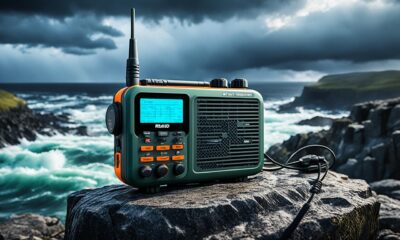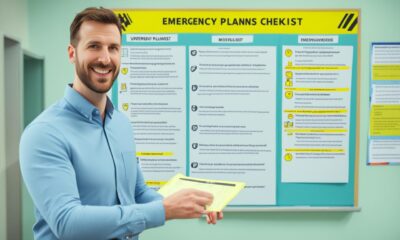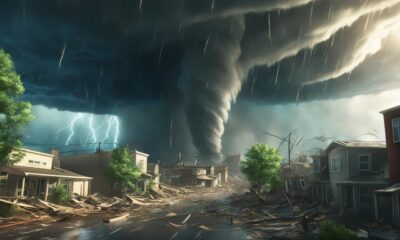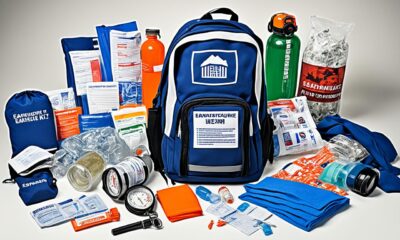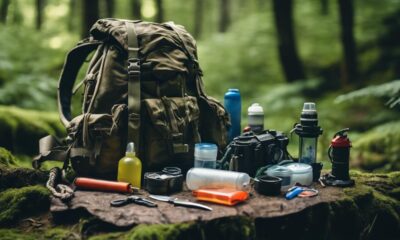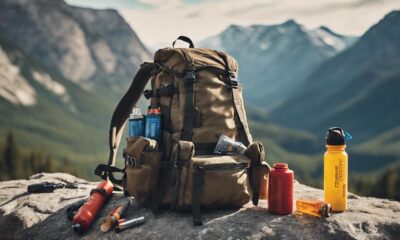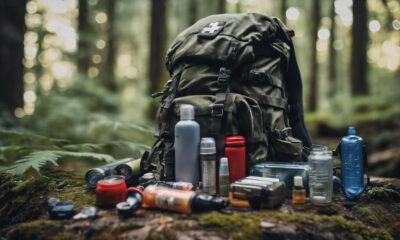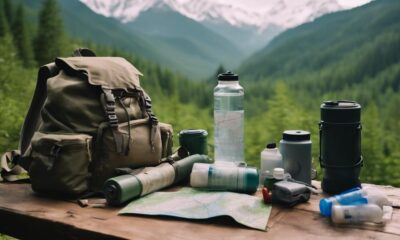Survivalism
Mastering Hurricane Preparedness: Your Essential Guide
Equip yourself with lifesaving tips and strategies for “Mastering Hurricane Preparedness” with our expert-crafted essential guide. Stay safe and informed.

Did you know Florida is often hit hard by hurricanes? This reveals how vulnerable the state is1. It faces many dangers like strong winds, flooding, and more because of its long coastline and inland areas1. It’s vital to know the risks in your area, such as how close you are to the coast and how well your home is built1.
Being ready for a hurricane is crucial. Taking steps early on can save lives and reduce damage1. A key part of being prepared is having a disaster supply kit. This kit helps you stay self-sufficient if the power goes out for a while1. Also, making your home stronger is important. You can do this by improving windows, doors, and adding hurricane shutters1.
Having a plan to communicate during a hurricane is essential1. It’s also important to know the difference between hurricane watches and warnings1. This helps you decide what to do next1.
Staying updated through the news, online, and weather radios is key during a hurricane1. Listening to local evacuation orders can keep you safe1. Sometimes, you may need to stay in your home if you can’t evacuate1.
Remember to think about people who may need extra help, like the elderly or those with special needs1. Staying inside, watching the storm’s path, and being ready for power losses and floods are part of staying safe1.(p>
After the storm, it’s important to check for damage and ask for help if needed1. Dealing with insurance and planning for the next hurricane are also crucial steps1. These tips will help you and your loved ones stay safe during a hurricane.
Key Takeaways:
- Understanding the specific risks of hurricanes based on location and home structure is crucial1.
- Creating a comprehensive disaster supply kit ensures self-sufficiency during power outages1.
- Reinforcing homes with upgrades like hurricane shutters is critical for fortification1.
- Developing a communication plan and staying informed through multiple channels is vital1.
- Heeding evacuation orders and making special arrangements for vulnerable populations is essential1.
Understanding the Risks of Hurricanes
Florida shines with beautiful beaches and a warm climate. But, it’s also in the path of many hurricanes. This makes it one of the most at-risk states in the U.S. Its people face many dangers because of these big storms.
Hurricane season runs from June 1st to November 30th each year. During these months, hurricanes hit the Southeast US the hardest, including Florida. These storms bring many challenges for the people and businesses there.
Hurricanes cause a lot of destruction. They can flood areas, bring high winds, and even cause tornados. This can lead to people needing to leave their homes, losing power for a long time, and seeing their property get damaged.
Places like South Florida are especially at risk. Cities such as Fort Lauderdale could face hurricanes, fires, floods, and even cyber-attacks2.
Businesses also struggle during hurricanes. They need a solid plan to keep going during these storms. This plan should include looking at risks, figuring out how the business could be affected, and making a strategy for recovery2.
To protect their goods, businesses need to store them safely. They also need to manage their inventory well and make sure they have the right insurance. Using technology helps businesses keep going, even during tough times2.
Having the right insurance is key for businesses. They should think about getting property, business interruption, and cyber insurance. These can help cover the cost of damages from hurricanes2.
It’s also smart for businesses to train their employees on what to do if a hurricane hits. Regular drills can teach everyone about evacuation and emergency methods. This way, when a storm comes, everyone knows what to do2.
Florida has resources to help people get ready for hurricanes. For instance, there’s a tax-free holiday to buy preparedness items. Businesses should have clear ways to talk during a crisis. They should know who to call and have backup ways to keep in touch2.
Since hurricanes are a big threat in Florida, everyone should understand the risks and how to reduce them. By being ready and staying strong, people and businesses can handle hurricanes better. This way, they can bounce back faster after the storm.
Hurricane Risk Reduction Tips:
- Stay informed about hurricane forecasts and warnings issued by weather authorities such as the National Oceanic and Atmospheric Administration (NOAA).
- Develop an emergency plan for your household that includes evacuation routes, communication methods, and meeting points.
- Prepare a disaster supply kit with essential items such as non-perishable food, water, medications, and important documents.
- Secure your home by reinforcing windows and doors, clearing gutters and drains, and trimming trees and shrubs.
- Follow evacuation orders from local authorities and seek shelter in designated safe areas.
- Keep emergency supplies, including a battery-powered radio, flashlights, and first aid kits, readily available.
- Stay connected with friends, family, and neighbors to provide support and assistance during and after a hurricane.
| Florida Hurricane Facts: |
|---|
| Florida is one of the most hurricane-prone states in the United States due to its geographical location. |
| The Atlantic Hurricane Season spans from June 1st to November 30th, with hurricanes most likely to occur in the Southeast US. |
| Hurricanes can cause severe coastal and inland flooding, storm surges, high winds, tornados, and heavy rainfall. |
| South Florida, specifically Fort Lauderdale, faces significant risks from hurricanes, fires, floods, and cyber-attacks. |
| Business continuity plans (BCP) are essential for organizations to outline operations during and after emergencies. |
| Proactive measures such as developing an emergency plan, practicing evacuation procedures, and leveraging technology can enhance hurricane preparedness. |
Preparing Your Disaster Supply Kit
Getting ready for a hurricane means putting together a disaster supply kit. This kit needs to have things like food that won’t go bad, water, medicines, and important papers. Being prepared with these items means you and your loved ones can stay safe even if the power goes out for a long time.
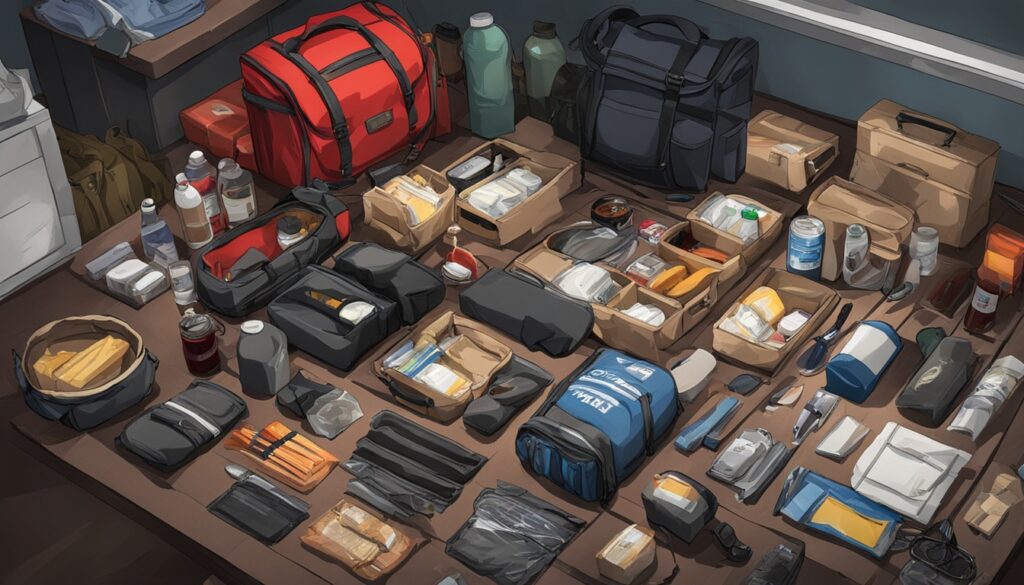
Essential Items for Your Disaster Supply Kit
What should you pack in your kit? Here are some must-haves:
- Non-perishable food: Fill your kit with canned goods, granola bars, and other foods that last a long time. You’ll need enough to keep everyone fed for 3 to 7 days.
- Water: Keep at least one gallon of water per person for each day. This water is for both drinking and staying clean. Don’t forget to swap out the water every six months.
- Medications: Stock up on prescriptions and over-the-counter meds for common problems.
- Important documents: Store copies of ID, insurance, and other critical paperwork in a waterproof container. This is important if you need to leave home quickly.
- First aid kit: Have a kit with bandages, antiseptic, gloves, and other medical supplies.
- Flashlight and batteries: Hurricanes often mean no power. A good flashlight and extra batteries are essential.
- Personal hygiene items: Things like toothbrushes, toothpaste, and toilet paper will keep you clean and comfortable.
- Emergency cash: Sometimes ATMs and cards won’t work. Keep some cash in your kit just in case.
Put these items in your disaster supply kit. Check and update your kit regularly. Being ready can give you peace of mind during hurricane season.
| Water Supply | Food Supply | First Aid Kit |
|---|---|---|
| Keep at least a three-day supply of water per person3. | Store at least a three-day supply of non-perishable food3. | Include two pairs of sterile gloves in the first aid kit3. |
| A normally active person needs at least two quarts of drinking water daily4. | Ensure your emergency kit should have non-perishable food supply for 3 to 7 days4. | Use 16 drops of regular household liquid bleach per gallon of water3. |
| Children, nursing mothers, and ill individuals need more water4. | Include essential medications in your disaster supply kit4. | Have a complete change of warm clothing and shoes per person3. |
| Hot temperatures can double the amount of water needed4. | Consider special needs items for infants, adults, seniors, and people with disabilities3. |
Don’t forget, you can call 2-1-1 for information on shelters and evacuation routes4. A well-stocked kit is crucial. It means you and your family can face storms safely.
Reinforcing Your Home
Your home is your safe place, and making it strong against hurricanes is important. Adding extra support to your windows and doors is a good step. Use hurricane shutters or strong glass to protect and stop damage inside your home.
Hurricanes have a scale, with five levels, based on how fast the wind blows according to5. The fiercest, Category 5, has winds over 157 mph and can ruin whole areas. So, it’s key to make sure your windows and doors can stand up to these forces.
Also, don’t forget about your roof. Check and make better the connections between your roof and walls. Use special straps or clips for extra hold during big storms6. This lowers the chance of roof and water damage inside.
Keeping your yard clean is smart too5. High winds can throw branches and stuff with force, causing damage. Trim your trees and secure loose things to keep your home and neighbors safe.
Start preparing before hurricane season hits. Get help from experts like contractors who can check your house and suggest ways to make it stronger6. This effort can really pay off by cutting down on damage and keeping your home standing through the storm.
In the table below, you can find a summary of recommended actions for reinforcing your home:
| Action | Benefits |
|---|---|
| Upgrade windows and doors with hurricane shutters or impact-resistant glass | Enhanced protection against strong winds and debris |
| Inspect and reinforce roof connections with hurricane straps or clips | Increased stability and reduced risk of roof damage |
| Trim trees and clear debris from your yard | Minimized risk of damage caused by flying objects |
| Seek professional assessment and guidance | Expert advice on reinforcement options tailored to your home |
By reinforcing your home, you safeguard your space and the people you love from hurricanes. Always check with local authorities for more tips on staying safe. Remember, it’s better to be prepared.
Developing a Communication Plan
Having a clear plan for talking during a hurricane is a must. It’s key to keep in touch with loved ones7. Pick someone you all trust to share news and stay updated. This person needs to be easy to reach, maybe with a working home phone or a cell that’s charged up89.
If power goes out, or cell service stops, have another way to talk. Think about texts, social media, or radios that still work without cell towers79. Make sure to try these methods out to know they’re ready to go.
Before a storm hits, update everyone’s contact info. Check that you have the latest phone numbers, emails, and social profiles for your main contact and others important to you79. This step is vital if you lose power or can’t get a signal.
Key Points:
- Develop a communication plan with a designated contact person8.
- Identify alternative methods of communication in case of power outages or cellular network disruptions79.
- Update contact information before a hurricane79.

| Statistics | Source |
|---|---|
| Potentially high percentage of families not together during a disaster | 8 |
| Approximate chance of local phone lines being jammed during a disaster | 8 |
| 55% of U.S. citizens turn to social media for their news | 9 |
Interpreting Hurricane Watches and Warnings
It’s key to know the difference between hurricane watches and warnings to act right. A watch means a hurricane might happen in your area. A warning tells you a hurricane is expected soon. This knowledge helps you get ready or leave if needed.
When a hurricane watch is out, stay alert and keep an eye on the weather. This alert means a big storm could come in the next 48 hours. It’s time to get your home safe, check your emergency kit, and plan what to do.
A hurricane warning means you need to act fast. It says a hurricane will hit within 36 hours. When you hear a warning, it’s time to either find safety or go to a shelter. This is when the storm is very close.
Hurricane alerts save lives and help keep property safe. Paying close attention to these warnings lets you make smart choices for you and your family. How you react can change based on how strong the hurricane is and your personal situation.
Reference:
- Statistical data extracted from the text related to hurricane preparedness for docks and fish houses.
- Statistical data extracted from the text related to the frequency of hurricane landfalls in the U.S. and the states most frequently affected.
- Statistical data extracted from the text related to hurricane wind categories, storm surge, and the definitions of hurricane watches and warnings.
| Statistical Data | Description |
|---|---|
| Season | Hurricane season in the southeastern United States and the Caribbean lasts almost half a year, from June through October10. |
| Risk Factors | Threats like high winds, tidal storm surges, and flooding are associated with hurricanes during this period10. |
| Preparedness | Owners of docks, fish houses, and vessels need to plan for storm season as part of normal maintenance practices10. |
| Recommendations | Vessel owners should consider going offshore during hurricanes for better storm survival10. |
| Category 5 Hurricanes | There have been only four Category 5 hurricanes that made landfall in the U.S.: “Labor Day” Hurricane (1935), Camille (1969), Andrew (1992), and Michael (2018)11. |
| Hurricane Warning | A hurricane warning indicates that hurricane conditions, including winds over 74 mph, will occur within 36 hours or less12. |
| Hurricane Watch | A hurricane watch announces that hurricane conditions, with winds over 74 mph, are possible within 48 hours12. |
| Storm Surge | Storm surge can be as high as 18 feet along South Florida coasts12. |
Staying Informed with Multiple Channels
In today’s world, it’s easy to keep up with hurricane news. You can use many methods like TV, the internet, and weather radios. These help you understand what to do during hurricane season.
TV and radio are old but reliable ways to get news. Local stations give updates on the weather, when to leave, and how to get help after a storm. They make sure you know what’s happening so you can protect yourself and your family.
Now, many people also use the internet for news. For instance, emergency teams post live updates on Twitter and Facebook. This means you can get the latest news fast, even if other ways to communicate are down.
Weather radios are another great tool. They work even if there’s no power, giving you news directly from NOAA. This includes warnings and local weather forecasts. Having a weather radio means you’re ready to make smart choices during a hurricane.
Each way to get news has its own benefits. For example, texts can get through when calls can’t, making them great during emergencies. It’s a good idea to keep your phone charged if a storm is coming. That way, you can get texts and stay in the loop.
Statistical data from link 1:13
Using different ways to get news helps you stay safe during a hurricane. You could watch TV, use social media, or listen to a weather radio. Key to safety is being informed, no matter how you do it, to look after yourself and loved ones.
Heeding Evacuation Orders
When local authorities issue mandatory evacuation orders, it’s vital to put safety first. Ignoring these orders risks lives and slows down emergency responders. So, it’s crucial to stay alert and act fast to evacuation calls.
The choice to call for evacuations comes after thorough analysis. Authorities look at the storm’s impact and how it affects community safety. They weigh factors like storm surge, wind speeds, and community vulnerability, aiming to keep everyone safe.
Evacuations are especially key for areas at risk of coastal dangers and floods. Hurricanes can bring huge damage, costing over $3 billion annually by 200014. Hundreds of communities face hurricane threats yearly, including minor coastal floods14. Some places also deal with floods from storms, heavy rains, and poor storm drainage14.
Evacuation orders aim to keep people safe. Data shows how vital it is to evacuate when hurricanes threaten. Annually, about ten tropical storms form, with six becoming hurricanes15. On average, five hurricanes hit the US coast every three years, causing 50 to 100 deaths15. Two of these are often major hurricanes, category 3 or above15.
A Hurricane Watch means hurricane conditions might happen within 36 hours. If a Hurricane Warning is given, it means strong winds of 74 mph could start in under 24 hours. These warnings give people time to prepare and find safe spots.
In hurricane areas, there are plans and shelters ready for evacuees. In Louisiana, people pack essentials like blankets, medication, and flashlights for evacuations15. Shelters there include schools in Iberville Parish15.
Evacuations are serious and based on solid science and experience. Following them can save lives and properties and ease emergency responders’ work. We must trust our local leaders and prioritize safety always.
Sheltering in Place
When a big hurricane comes and leaving isn’t an option, staying put is essential. Making sure your home is safe and gathering needed supplies is key. Hurricanes are ranked from Categories 1 to 5 based on their wind speed. Categories 3 and up are major, causing a lot of harm and sometimes loss of life.
Getting ready means having food, water, and other essentials. You should have at least a 3-day supply of food that won’t spoil and a gallon of water per person each day. Also, grab a manual can opener, a flashlight, a first aid kit, batteries, and a battery-powered radio or TV.
Choosing a safe room is very important when you have to stay in place. Pick a room without many doors or windows and one that has water access. The American Red Cross says to choose a room that’s not on the ground floor to stay safe from hazards. Don’t seal off your entire place, just focus on one room.
If a hurricane watch is issued, it’s crucial to act quickly and stay updated. Local officials will tell you when to stay put. Keep watching or listening to the news until it’s safe to come out.
Your safety is the most important thing during this time. Don’t try to save pets if it’s not safe. Make sure to stay in touch with others by phone or radio to get the latest updates.
Staying in place may be your only choice if you can’t leave. By securing your home, having supplies, and following updates, you keep yourself and your family safer. Always follow what the local authorities and emergency teams tell you. Being prepared and acting wisely is key to getting through the storm safely.
Protecting Vulnerable Populations
It’s crucial to look after people with special needs, like seniors, those with disabilities, and people with health issues. Working with local leaders and groups helps make sure they are safe. They need plans that cover travel and where to find shelter or medical help.
Research shows how important it is to protect these groups during disasters. For instance, earthquake-resistant buildings can save lives and lower damage. This is highlighted in16.
Being ready for emergencies is key to keeping vulnerable groups safe. Making escape plans, storing food and water, and setting up shelters can be life-saving. These steps are critical for the safety of those with special needs, as16 shows.
Good emergency planning can mean the difference between life and death. Making plans that consider everyone’s needs, including the homeless and disabled, is vital. This ensures their safety, as16 stresses.
Being prepared not only keeps people safe but also eases their minds. Clear plans give a sense of security to victims and helpers alike. This support is outlined in16.
It’s also important to keep essential services going. Back up important papers and have a plan for who takes over key roles. This helps recovery after a disaster, as pointed out in16.
Meeting the needs of those at risk requires experts in emergency management. Those trained in this area are key to making effective plans, leading rescue efforts, and lessening the impact of disasters. This is highlighted in16.
To help those in need during emergencies, getting a specialized degree is helpful. Programs like Walden University’s MS in Criminal Justice focus on Emergency Management. They offer a way to study while working, helping you advance in your career, as mentioned in16.
Protecting those in need during a disaster means planning ahead with authorities and community groups. By focusing on their specific needs and challenges, we can keep everyone safe and well.
Staying Safe During the Storm
When a hurricane hits, it’s key to stay inside, far from windows, in a safe room of your house. This keeps you safe from things flying around because of the strong winds17.
Keeping an eye on the storm’s updates is very important. Make sure to follow the latest news from reliable sources like the National Hurricane Center (NHC) and your local weather station18.
If you hear about a hurricane warning, you need to act fast. Listen to what local officials say. Get ready to leave if they tell you to1719.
Only go outside when the local authorities say it is safe. Avoid any unnecessary dangers by staying inside until they say it’s okay19.
Your safety and your family’s safety should always come first. Follow the advice and rules from authorities to stay safe during the storm1719.

| Stay Safe During the Storm: | References |
|---|---|
| Stay indoors, away from windows, and in a secure, interior room. | 17 |
| Monitor the storm’s progress through trusted information sources. | 18 |
| Follow instructions and guidance from local officials during a hurricane warning. | 1719 |
| Avoid venturing outside until authorities declare the area safe. | 19 |
| Priority should be given to the safety of yourself and your loved ones. | 1719 |
Addressing Power Outages
Power outages often happen during hurricanes. It’s critical to be ready to keep everyone safe. Here are some tips to deal with power outages and be prepared:
1. Have Alternative Power Sources
Having backup power is key when electricity goes out. Keep flashlights, batteries, and a generator or power bank handy. They help you see in the dark and keep devices running. Yet, remember generators can be dangerous. Always use them in well-ventilated areas to avoid risks like carbon monoxide poisoning20.
2. Preserve Food and Water
Without power, fridges and freezers stop cooling. To prevent food from spoiling, don’t open fridge doors too often. A full fridge keeps food safe for up to four hours, and a packed freezer does so for 48 hours. Half-full freezers keep food for 24 hours. Plan your meals to limit opening the fridge21.
Clean water access is vital during power issues. Sometimes, water supply gets hit. Keeping a slow trickle of water flowing can keep pipes from freezing. Wrapping pipes with newspapers and plastic also helps protect them. These steps prevent damage and keep water flowing21.
3. Consider Home Generators
A home generator can lessen the effects of power outages. It supports crucial needs like heating and cooling during emergencies. Having a reliable power source when the grid fails is beneficial. However, installing and using a generator safely is a must to avoid accidents21.
4. Prioritize Safety Measures
In power outages, keeping safe is essential. Don’t drive over power lines; they’re dangerous. Also, don’t park under trees to prevent damage from falling branches. Focusing on safety helps everyone during tough times21.
5. Optimize Technology Usage
To handle power outages, use technology wisely to save battery life. Keep phones charged and use less power where you can, like lowering screen brightness. Surge protectors can guard against power surges. These steps keep your technology working longer21.
By taking these steps for power outage readiness, people can stay safe and connected. It helps communities manage better during emergencies2120.
Reference:
Navigating Flood Conditions
Flooding spells big trouble during hurricanes. It wrecks homes and puts lives at risk. Knowing what to do, evacuating when told, and being safe matters a lot for you and your family.

Flood Risks During Hurricanes
Hurricanes unleash winds and rains that flood places. FEMA says floods are 90% of U.S. natural disasters. Floods hit without warning, especially in coastal and low areas.
But, floods can strike anywhere. Climate experts warn of more floods ahead. It’s key to understand flood dangers everywhere22.
Evacuation and Safety Precautions
Local officials’ evacuation orders are critical. If you’re in a risky area, plan your exit early. And remember, driving or walking through floods is dangerous22.
To protect yourself and your home, follow these tips:
- Shut off electricity, gas, and water to avoid accidents and electrocution risks.
- Move valuable things up high or into waterproof containers.
- Keep documents and insurance safe or in the cloud.
- Have an emergency kit with food, water, medicines, and a radio.
- Use a battery or hand-crank radio to hear weather updates from the National Weather Service (NWS)22.
Understanding Different Types of Floods
Knowing flood types helps you prep better. Coastal floods come from storm surges. Flash floods happen fast because of rain. Inland floods are when rivers overflow. This knowledge lets you act right in different situations22.
To get ready, learn from experts like Xylem. They’ve dealt with weather troubles for over 35 years. They rent out pumps for floods and offer non-stop help. Their pro, Hunter Powell, shares tips on avoiding hurricane damage23.
Being wise about floods, planning for leaving, and staying safe lets you handle hurricane floods better. This keeps you and your things safer. Learn, prepare, and be careful.
Conclusion
Learning to prepare for hurricanes is key to protecting your home and family. The hurricane season in the US goes from June 1 to November 30. Each year, the Atlantic Ocean, Caribbean Sea, and Gulf of Mexico see about six hurricanes. The US coast gets hit by three hurricanes every two years. One usually is a major one, with Category 3 or higher24. Knowing these facts helps you get ready and lessen their effects.
Hurricane winds can blow up to 150 mph. Storm surges may raise water levels by 30 feet or more. This makes homes along the Gulf and East Coasts very at risk24. Florida faces the most danger from hurricanes24. These storms can bring flash floods, floods, and even tornadoes. The need for getting ready is clear24. The NOAA uses the SLOSH model to predict storm surges from many factors24.
Texas, with its unique coastal areas, faces special challenges. Studies like the Storm Surge Suppression and the Texas Coastal Infrastructure Study are looking into these challenges25. Texas has 367 miles of Gulf beaches and over 3,300 miles of bays. It knows it’s crucial to protect its coast25.
A study on hurricane preparedness in Miami Beach hotels showed how important planning is26. This research looked at how hotels respond to hurricane warnings and manage evacuations. It emphasized making sure hotels and the hospitality industry are ready for storms26. It used detailed stats and information on past hurricanes to suggest better planning and preparedness26.
Making your home and family safer from hurricanes means using the latest findings and being proactive. Use stronger building materials and consider renewable energy. Always update your emergency plans. Being prepared means you and your loved ones can bounce back stronger after a storm24. Remember, being ready and resilient helps you withstand and recover from the storm with strength.FAQ
What are the risks associated with hurricanes?
What should I include in my disaster supply kit?
How can I reinforce my home against hurricanes?
How do I develop a communication plan for hurricanes?
What is the difference between a hurricane watch and a hurricane warning?
How can I stay informed about hurricanes through multiple channels?
What should I do when there is a mandatory evacuation order?
What should I do if I cannot evacuate and need to shelter in place?
How can I protect vulnerable populations during a hurricane?
How can I stay safe during the height of a hurricane?
How should I address power outages during a hurricane?
What precautions should I take to navigate flood conditions during a hurricane?
How can I incorporate resilience-building measures into my long-term plans for hurricane preparedness?
How Can I Adapt My Hurricane Preparedness Guide to Include Flood Survival Tactics?
When updating your hurricane preparedness guide, be sure to include essential flood survival tips. Plan escape routes to higher ground, secure important documents in waterproof containers, and stock up on emergency supplies like non-perishable food, water, and first-aid kits. Stay informed about potential flooding in your area and be ready to take action.
Source Links
- Mastering Hurricane Preparedness: A Comprehensive Guide For All Of Florida
- Ready for Anything? Emergency Preparedness for Hurricane Season and Beyond | Crown Center Executive Suites
- Prepare an Emergency Supply Kit
- Preparing for Hurricane Season – United Way of Central Florida
- Hurricane Preparedness: 7 Crucial Steps to Safeguard Your Home and Loved Ones
- Mastering Hurricane Security: A Comprehensive Guide | American Hurricane Shutters
- Mastering Hurricane Preparedness: Evacuation Plan – BSA Claims
- How To Create an Emergency Communication Plan | ServiceMaster Restore®
- Developing a Disaster Communication Plan
- All About Hurricanes – Earth Networks
- Hurricane Terminology
- Mastering Hurricane Preparedness: Safeguarding Your Home and Family – Goodlad & Swank
- Hurricane Info & Preparation – I-CAER
- why-emergency-preparedness-matters
- 5 Hurricane Safety Tips to Stay Safe During the Storm
- What You Need to Know – UF Business Affairs
- MEMA ISSUES POWER OUTAGE SAFETY TIPS
- Power Outages: What to Do Before, During, and After an Outage
- Flood Preparedness: What You Need to Know
- Hurricane Equipment & Preparedness Plans | Xylem Master
- Hurricane Preparedness Plan – A guide from AXA XL Marine
- Hurricane Preparedness & Planning
- A study to analyze the degree of hurricane preparedness in selected Miami Beach hotels
Survivalism
Surge in Preppers: Trends and Insights Revealed
Join the exploration of the rising prepper movement and discover the surprising factors driving this trend—what could it mean for you?
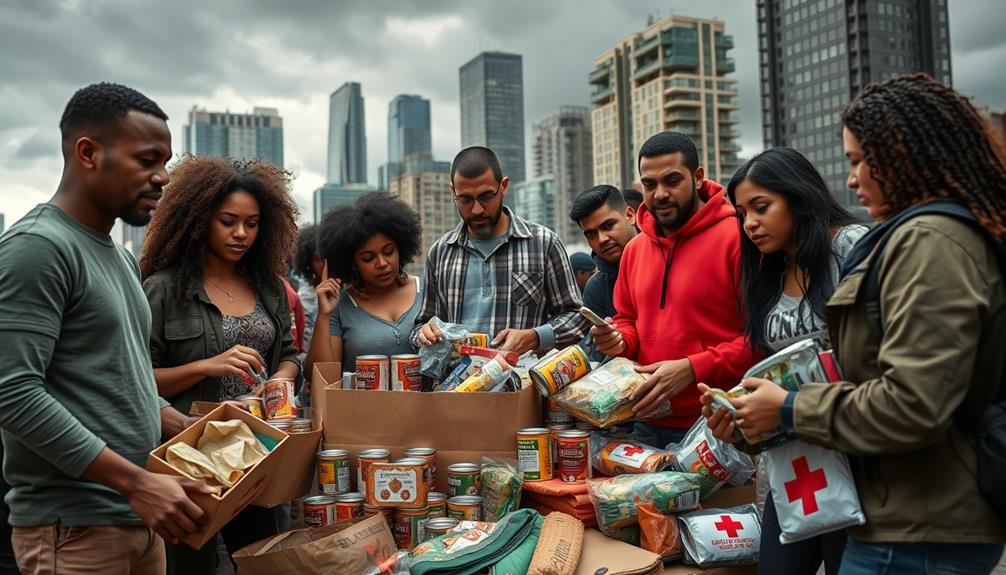
You're not alone if you've noticed a surge in preppers. Nearly 30% of U.S. households, or about 25.8 million people, are now taking steps to prepare for uncertainty. Many younger adults cite climate change and societal instability as key motivations. With the COVID-19 pandemic impacting supply chains, awareness and demand for survival supplies have skyrocketed. Curiously, there's a growing number of women and younger individuals joining this movement, reflecting a diverse community. Understanding this trend can empower you and your community in managing future challenges, so keep exploring these insights further to uncover more essential information.
Key Takeaways
- The prepper community has grown to 30.3% of U.S. households, driven by concerns over climate change and societal instability.
- Younger adults, particularly Gen Z, increasingly participate in prepping, with about 40% identifying as preppers.
- Economic factors, including supply-chain disruptions, have heightened awareness and investment in preparedness resources.
- Significant gaps exist in American preparedness, with 44% lacking a first-aid kit and many missing critical emergency documents.
- Educational initiatives focused on first aid and community drills are essential to enhance preparedness and resilience in communities.
Prevalence and Demographics

Identifying as a prepper is becoming increasingly common in the U.S., with around 30.3% of households—approximately 25.8 million individuals—embracing this lifestyle in 2023.
This movement isn't confined to specific demographics; people from various backgrounds are joining in. Younger adults, in particular, are stepping up, motivated by concerns about environmental degradation and societal instability.
The community also features a notable gender dynamic, with 69% of preppers being male and 31% female, and female participation is on the rise.
Racially, the majority are white (81.8%), but diversity is growing as more individuals from different backgrounds become involved.
Motivations for Preparedness

The growing number of preppers reflects a heightened awareness of various global challenges that motivate individuals to take action. Concerns about climate change, pandemics, and civil unrest drive many to adopt preparedness strategies. You might find yourself stockpiling essentials or learning self-reliance skills.
Here's a quick look at some key motivations:
| Motivation | Percentage of Preppers | Examples |
|---|---|---|
| Climate Change | 45% | Gardening, water storage |
| Pandemics | 30% | Non-perishable food stock |
| Civil Unrest | 25% | Emergency kits, self-defense |
These motivations not only enhance personal safety but also foster community resilience, showing that prepping is about more than just survival—it's about thriving in uncertain times.
Economic Influences on Prepping
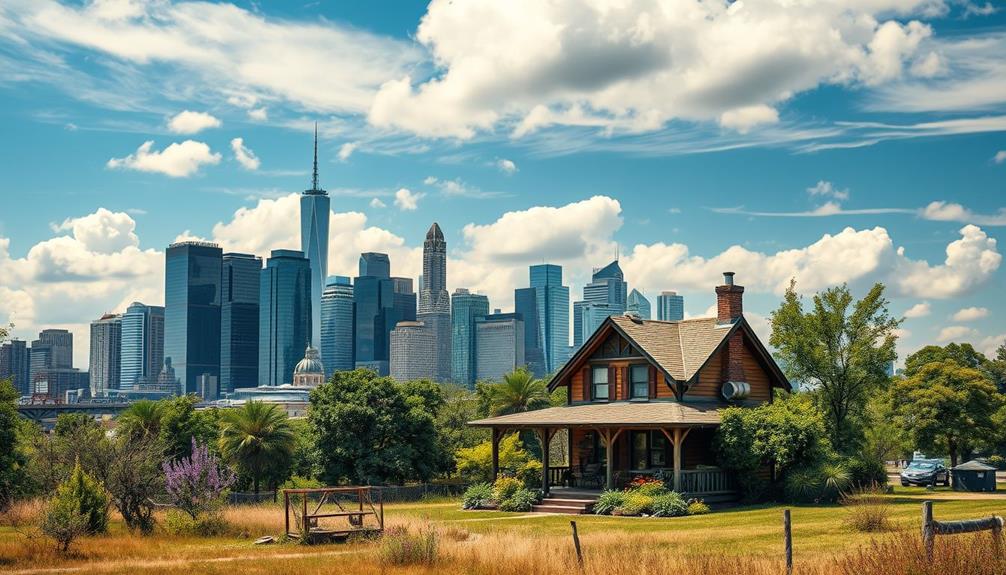
Economic influences play a significant role in shaping the prepping landscape. You might notice how financial factors impact your decisions and resources. As income levels vary, so do the abilities to invest in prepping.
- Supply-chain disruptions during COVID-19 heightened awareness and urgency around preparedness.
- The global survival tools market is projected to reach $2.46 billion by 2030.
- Resilient Citizens typically earn $54,000, allowing for greater investment in supplies compared to regular citizens.
- Average emergency savings for Resilient Citizens stand at $15,779, highlighting a financial edge in preparedness.
- Increased demand for prepping resources reflects a growing societal acceptance of self-sufficiency and readiness.
These economic factors underscore the importance of financial planning in your prepping journey.
Identifying Preparedness Gaps

Nearly half of Americans, about 44%, don't have a first-aid kit, revealing a significant preparedness gap that needs addressing. This lack of basic supplies highlights a broader issue: many also lack copies of critical emergency documents.
In addition, preparing a bug out bag can be an essential step in ensuring you have necessary items ready for any situation. Without these essentials, you're putting yourself at risk during emergencies.
The urgency for CPR training can't be overstated, as the survival rate for cardiac arrest without it's zero. By identifying these gaps, you can take proactive steps, like investing in emergency preparedness courses or creating a thorough emergency plan.
Engaging with your community to promote awareness and accessibility can also enhance overall preparedness, ensuring that you and your neighbors are ready for unexpected situations.
Educational Needs in Communities

Communities face significant educational needs in emergency preparedness, underscoring the importance of equipping individuals with essential skills and knowledge. Many people lack basic preparedness tools and training, which can jeopardize safety during crises.
To address these gaps, communities can focus on the following educational initiatives:
- First-Aid Training: Teach essential lifesaving techniques to empower individuals.
- Emergency Kits: Provide guidance on assembling thorough survival kits.
- Document Preparedness: Offer workshops on organizing critical emergency documents.
- Community Drills: Conduct regular drills to practice response strategies.
- Resource Accessibility: Create platforms for sharing local emergency resources and support networks.
Future Trends in Prepping

As we look ahead, the prepper movement is set to expand further, driven by rising concerns about climate change, pandemics, and societal unrest.
You'll likely see younger generations, particularly Gen Z, embracing prepping more than ever, with around 40% identifying as preppers. This trend reflects a shift towards self-sufficiency and community resilience.
As supply-chain issues persist, expect businesses to cater to the growing demand for survival supplies and emergency kits.
Additionally, educational initiatives will become essential, equipping individuals with necessary skills like first aid and gardening.
As you navigate this evolving landscape, staying informed and adaptable will be key to thriving in an increasingly uncertain world.
The future of prepping is bright, with opportunities for innovation and collaboration.
Political Diversity Among Preppers

Within the prepper community, political diversity plays an essential role in shaping the movement's identity and growth. You'll find preppers from various political backgrounds, each bringing unique perspectives on preparedness. This diversity enhances discussions and initiatives, fostering a more inclusive environment.
- Environmentalists prepping for climate change impacts
- Libertarians promoting self-sufficiency and minimal government
- Urban dwellers focused on community resilience
- Traditionalists valuing heritage skills and self-reliance
- Younger generations advocating for innovative solutions
Embracing this political spectrum encourages collaboration, as preppers unite around common goals like safety and sustainability. This proves that the need for preparedness transcends party lines.
Understanding these dynamics enriches your experience within the prepping community.
Frequently Asked Questions
What Are the Best Resources for Beginner Preppers?
To start prepping, you should explore online forums, read survival books, and watch instructional videos. Joining local prepping groups can also provide support, resources, and hands-on experiences to enhance your skills and knowledge effectively.
How Can Prepping Contribute to Community Resilience?
Prepping builds community resilience, with 25.8 million Americans identifying as preppers in 2023. By sharing resources and skills, you strengthen local networks, ensuring everyone's better equipped to face emergencies and challenges together.
Are There Specific Prepping Strategies for Urban Environments?
In urban environments, you can focus on space-efficient storage, creating emergency kits tailored to city needs, establishing community networks, and learning essential skills like gardening on balconies or rooftops for self-sufficiency and resilience.
What Psychological Impacts Can Prepping Have on Individuals?
Prepping can bring both peace of mind and anxiety. You feel empowered by self-sufficiency, yet fear the unknown. Balancing preparedness with reality helps you navigate these psychological impacts, fostering resilience in uncertain times.
How Can Preppers Stay Informed About Emerging Threats?
To stay informed about emerging threats, you should regularly follow news outlets, join prepper forums, attend workshops, and engage with local community groups. Networking with like-minded individuals can enhance your preparedness knowledge and awareness.
Conclusion
As you navigate this evolving landscape of preparedness, remember that being a prepper isn't just about stockpiling supplies—it's about building resilience for whatever life throws your way. Like a modern-day Noah, you have the power to weather storms, whether they're natural disasters or societal shifts. Embrace the diversity of motivations among your peers and recognize that knowledge is your greatest asset. With the right skills and mindset, you can face the future confidently, prepared for anything.
Survivalism
Essential Headlamps for Survival Preparedness
Get ready to explore the crucial features of headlamps for survival preparedness and discover how the right choice can enhance your safety and confidence.
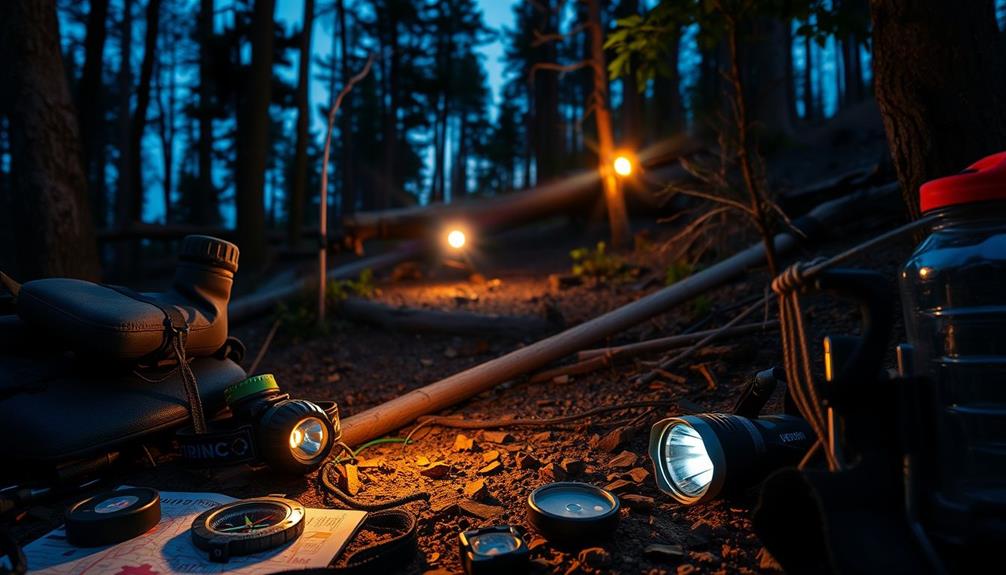
Headlamps are essential for survival preparedness, providing hands-free illumination in low-light conditions. You'll want to choose one that offers high brightness, adjustable settings, and durable construction. Look for reliable models like the ThruNite TH20 Pro for its 1000 lumens or the lightweight Liteband 400, ideal for extended wear. Always check battery options and verify they're easy to replace or recharge. Regular maintenance, such as battery checks and strap inspections, keeps your gear functional. Equipped with the right headlamp, you'll boost your confidence and safety in emergency situations. There's more to discover about optimizing your survival gear.
Key Takeaways
- Choose headlamps with high brightness (1000+ lumens) for optimal visibility in dark survival scenarios.
- Look for adjustable brightness settings to adapt to varying conditions and tasks.
- Opt for durable, waterproof models to withstand tough environments and ensure reliability.
- Select rechargeable battery options for sustainability and easy power access in emergencies.
- Prioritize comfort with lightweight designs and adjustable straps for extended wear during preparedness activities.
Importance of Headlamps
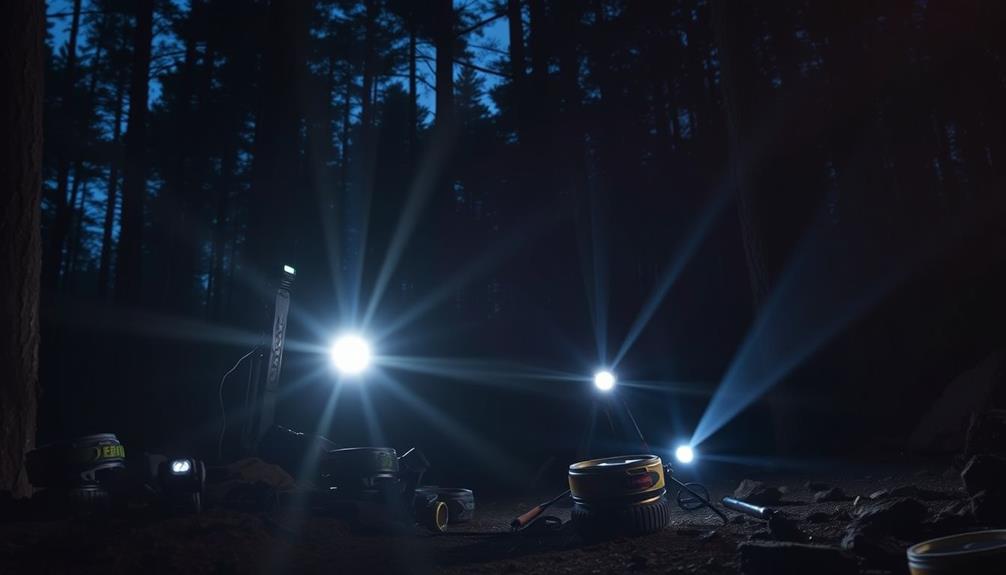
When it comes to survival preparedness, headlamps are invaluable tools that provide essential visibility in low-light situations. They allow you to keep your hands free while maneuvering, setting up camp, or performing critical tasks during emergencies.
With a headlamp, you can easily illuminate your surroundings without needing to hold a flashlight, enhancing both safety and efficiency. This is particularly important when you're in unfamiliar terrain or facing unexpected challenges.
In addition, headlamps are compact and lightweight, making them easy to carry in your emergency kit. Whether you're camping, hiking, or preparing for a power outage, having a reliable headlamp on hand can greatly improve your overall preparedness and confidence in low-light scenarios.
Key Features to Evaluate
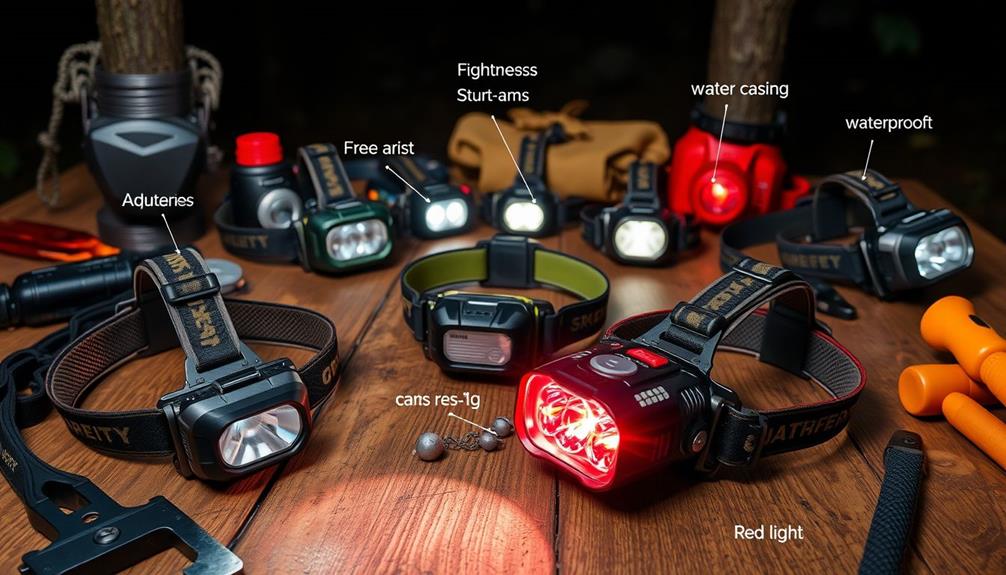
Evaluating the key features of headlamps is vital for guaranteeing you choose the right one for your survival needs.
When reviewing headlamps, keep the following features in mind:
- Brightness: Look for higher lumens for better visibility.
- Adjustable brightness settings: These allow you to adapt to different scenarios.
- Battery options: Consider whether you prefer disposable or rechargeable batteries.
- Comfort and fit: A lightweight design with adjustable straps is important for extended use.
- Durability: Confirm that the headlamp is waterproof and impact-resistant for tough conditions.
Top Recommended Models
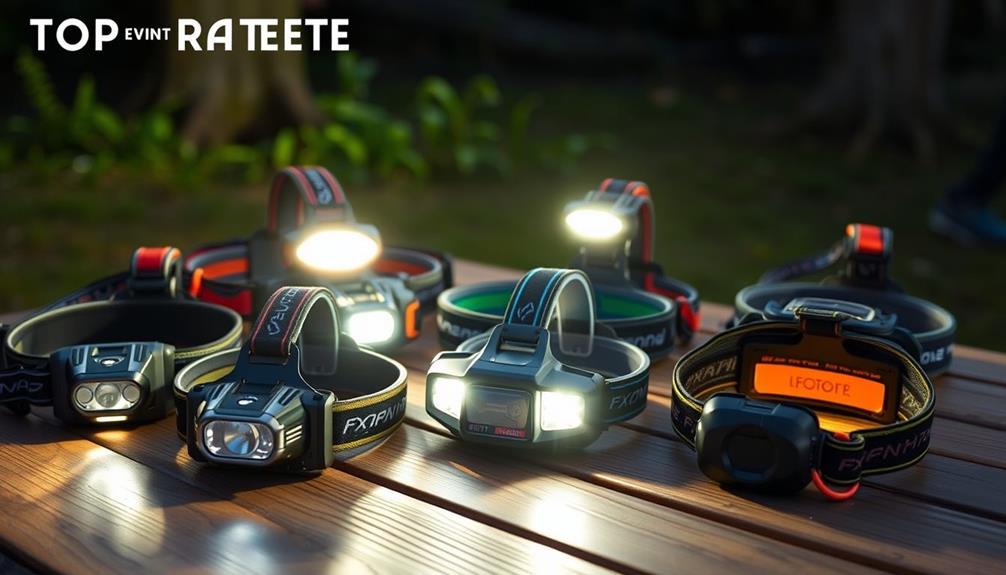
Choosing the right headlamp can greatly enhance your survival preparedness.
You'll want to take into account models that suit your specific needs. The ThruNite TH20 Pro offers an impressive 1000 lumens, making it perfect for dark survival scenarios.
If you prefer something lightweight, the Liteband 400 provides 350 lumens and is comfortable for extended wear.
For versatility, look at Model E, which features advanced capabilities like motion sensors and adjustable brightness.
The rechargeable Model C with USB compatibility guarantees you won't run out of power when you need it most.
Finally, Model D is a reliable, affordable option for beginners.
Each model has unique features, so pick one that aligns with your activities and preferences.
Practical Uses for Headlamps

Headlamps serve multiple practical uses, making them invaluable tools in various situations.
Whether you're camping, hiking, or dealing with an emergency, headlamps provide hands-free lighting, allowing you to focus on tasks safely.
Here are some practical applications:
- Setting up camp after dark
- Finding your way on trails or paths in low light
- Performing repairs on vehicles or equipment
- Reading or cooking in dimly lit areas
- Emergency lighting during power outages
With their versatility, headlamps can easily adapt to your needs, ensuring you're always prepared.
Plus, they're lightweight and easy to carry, making them a must-have for any survival kit.
Don't underestimate the power of a good headlamp!
Maintenance and Care Guidelines

To keep your headlamp in top condition, regular maintenance is key. Start by checking and replacing or recharging batteries to guarantee peak performance. Clean the lens with a soft cloth to maximize brightness, and store your headlamp in a cool, dry place to prevent damage. Inspect straps and components regularly for wear and tear.
Here's a quick maintenance guide:
| Maintenance Task | Frequency | Notes |
|---|---|---|
| Battery Check | Monthly | Replace or recharge as needed |
| Lens Cleaning | As needed | Use a soft, dry cloth |
| Functional Test | Every 3 months | Confirm all features work |
Choosing the Right Battery
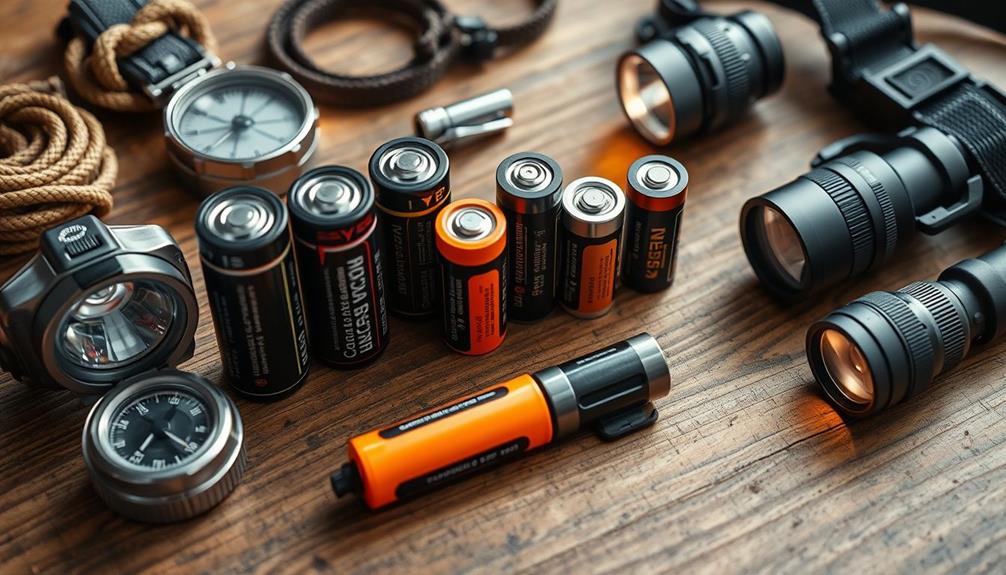
Selecting the right battery for your headlamp can greatly impact its performance and longevity.
You'll want to take into account several factors when making your choice. Here are some key points to keep in mind:
- Battery type: Decide between disposable alkaline or rechargeable lithium-ion batteries based on your needs.
- Capacity: Look for batteries with higher milliamp-hour (mAh) ratings for longer run times.
- Availability: Make certain you can easily find replacement batteries, especially in emergency situations.
- Weight: Reflect on the weight of the battery, as it affects overall comfort during extended use.
- Shelf life: Opt for batteries with a longer shelf life to guarantee they're ready when you need them.
Enhancing Survival Preparedness

Enhancing your survival preparedness involves more than just gathering essential gear; it requires a strategic approach to guarantee you're ready for any situation. A well-rounded plan includes not only headlamps but also understanding their applications, maintenance, and compatibility with other gear.
Consider these factors when enhancing your preparedness:
| Feature | Importance | Action Required |
|---|---|---|
| Brightness Levels | Different environments require varying brightness | Test your headlamp in different settings |
| Battery Type | Affects longevity and convenience | Stock up on backup batteries |
| Durability | Resilience in tough conditions | Inspect gear regularly |
Frequently Asked Questions
How Do I Choose Between Different Headlamp Brands?
When choosing between headlamp brands, consider brightness, battery type, comfort, and durability. Compare features like adjustable settings and weight. Read reviews to find what suits your activities best, ensuring you make an informed choice.
Can I Use a Headlamp for Fishing or Hunting?
Picture a shadowy lake at dusk; a headlamp's beam pierces the darkness. Yes, you can use a headlamp for fishing or hunting, providing hands-free light to spot your target and navigate safely.
What Is the Lifespan of a Typical Headlamp?
A typical headlamp's lifespan varies, but you can expect around 1,000 hours of use from LED models. Regularly check the batteries and clean the lens to maximize performance and guarantee reliable illumination when needed.
Are There Headlamps Suitable for Children?
Imagine a tiny explorer, traversing through the dark woods. For your young adventurer, consider lightweight, adjustable headlamps designed for kids. They're bright yet safe, allowing them to illuminate their path while having fun.
How Do I Properly Dispose of Old Batteries?
You should never throw old batteries in the regular trash. Instead, find a local recycling center or retailer that accepts batteries, ensuring they're disposed of safely and responsibly to prevent environmental harm.
Conclusion
In the wilderness of uncertainty, a headlamp is your guiding star, illuminating the path ahead while keeping your hands free to tackle challenges. With the right gear by your side, you're not just prepared; you're empowered. Whether you're setting up camp under a canopy of stars or steering through the shadows of an unexpected adventure, the right headlamp becomes a beacon of safety and convenience, lighting the way for every step you take. Embrace the journey!
Survivalism
Break These Habits for Ultimate Preparedness
Start breaking these habits today to boost your preparedness and discover powerful strategies for thriving in any situation that may arise.
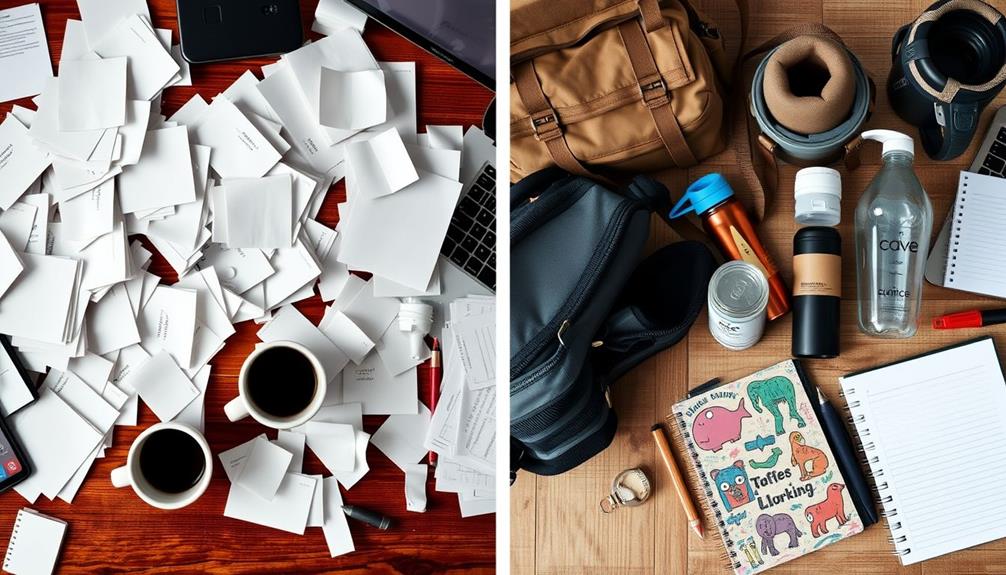
To achieve ultimate preparedness, you need to break habits that hold you back. Start by practicing good hygiene, like regular hand washing, to keep germs at bay. Improve your sleep quality by setting a routine and limiting screens before bed. Stay active—avoid prolonged sitting and incorporate movement into your day. Make healthier dietary choices by planning meals and prioritizing whole foods. If you smoke, quitting is key for physical and financial health. Enhance your mental resilience through mindfulness and community support. By letting go of these habits, you'll strengthen your preparedness for any situation that comes your way, and there's more to explore.
Key Takeaways
- Regular hand washing and using hand sanitizer can prevent the spread of germs and enhance overall preparedness against infections.
- Establish a consistent bedtime routine to improve sleep quality, essential for optimal decision-making during emergencies.
- Limit sedentary behavior by incorporating regular physical activity, which boosts energy levels and mental acuity.
- Focus on healthier dietary choices, like meal planning and hydration, to strengthen your immune system and resilience.
- Quitting smoking improves health and financial stability, contributing to better preparedness in crisis situations.
Hygiene and Infection Control

Maintaining good hygiene is essential for reducing infection risks, especially during emergencies. You should wash your hands regularly, as skipping this vital step can greatly increase your chances of getting sick.
The CDC recommends lathering for at least 20 seconds to effectively remove pathogens. When soap and water aren't available, keep hand sanitizer in your survival kit.
Avoid habits like nail biting and nose picking, as these can transfer harmful germs directly to your mouth and lead to various health issues. Instead, practice mindfulness techniques to manage these habits, and keep your nails trimmed to reduce temptation.
Improving Sleep Quality

A good night's sleep is essential for your overall preparedness and well-being. Insufficient sleep can hinder your decision-making and increase stress, making you less resilient in emergencies.
To improve your sleep quality, try these four tips:
- Establish a bedtime routine: Going to bed at the same time each night signals your body it's time to wind down.
- Limit screen time: Reduce exposure to screens at least an hour before bed to enhance melatonin production.
- Create a serene environment: Use earplugs and eye masks to block out distractions and promote relaxation.
- Cut caffeine intake: Avoid caffeine after mid-afternoon, as it can disrupt your ability to fall asleep.
Reducing Sedentary Behavior

Improving your sleep quality sets a strong foundation for overall wellness, but it's equally important to tackle sedentary behavior that can undermine your preparedness.
Sitting for prolonged periods can harm both your physical and mental health, leading to issues like obesity and cardiovascular disease. Aim for at least 150 minutes of moderate activity each week.
Simple changes, like using a standing desk, taking walking breaks, or incorporating short workouts, can make a big difference. Consider joining fitness classes to make exercise enjoyable and social.
By breaking up your sitting time and staying active, you'll boost your energy levels, enhance mental acuity, and increase your overall resilience in any situation.
Don't let a sedentary lifestyle hold you back!
Healthier Dietary Choices

Making healthier dietary choices can greatly boost your preparedness and resilience during emergencies.
By fueling your body with nutrient-dense foods, you'll enhance both your physical and mental well-being.
Here are four key strategies to improve your dietary habits:
- Plan Meals: Create a weekly meal plan to avoid impulse buys and guarantee you have nutritious options on hand.
- Focus on Whole Foods: Prioritize fruits, vegetables, whole grains, and lean proteins to support your immune system.
- Practice Mindful Eating: Slow down during meals to reduce stress and promote better digestion.
- Stay Hydrated: Drink plenty of water to maintain peak cognitive and physical performance.
Quitting Smoking and Dependencies

Breaking free from smoking and dependencies is essential for enhancing your overall preparedness and resilience. Smoking not only drains your finances—over $1,500 a year—but also jeopardizes your health, making you less self-sufficient during emergencies. Quitting can lead to better financial stability and improved physical well-being.
Here's a quick comparison of the benefits of quitting versus continuing:
| Quitting Smoking | Continuing to Smoke |
|---|---|
| Saves money | Wastes money |
| Improves lung health | Damages lungs |
| Boosts energy levels | Causes fatigue |
| Enhances decision-making | Impairs cognitive function |
| Strengthens resilience | Weakens preparedness |
Embrace the journey towards a smoke-free life; your future self will thank you.
Building Mental Resilience

Quitting smoking not only bolsters your finances and health but also lays the groundwork for building mental resilience.
Additionally, maintaining a healthy lifestyle can strengthen your overall well-being, which is essential for mental fortitude.
To enhance your mental strength, focus on these key practices:
- Cultivate a Positive Mindset: Embrace optimism to improve your coping strategies during crises.
- Engage in Mindfulness: Regular mindfulness techniques can reduce anxiety and sharpen your focus.
- Develop Problem-Solving Skills: Tackle challenges head-on by practicing analytical thinking and decision-making.
- Seek Community Support: Surround yourself with supportive individuals who can provide encouragement and share experiences.
Incorporating practices such as proper nutrition, which can impact mental health, is also beneficial for resilience gout-friendly diet.
Smart Financial Preparedness

When it comes to smart financial preparedness, having a solid plan in place can make all the difference during emergencies. Start by establishing a budget specifically for prepping—aim for around $800 to $1,000 for individuals and $2,500 for families. This helps prioritize essential items and prevents overspending on unnecessary gear.
Embrace the "buy once, cry once" philosophy; invest in high-quality, durable supplies rather than cheap, disposable alternatives. Additionally, understanding your budget can help you allocate resources effectively.
Keep an emergency fund that covers at least three to six months of living expenses. This cushion provides peace of mind and financial stability during crises.
Enhancing Decision-Making Skills

To enhance your decision-making skills, regularly practicing critical analysis techniques is key. By sharpening your ability to evaluate situations, you'll make more informed choices.
Here are four effective strategies to develop these skills:
- Engage in scenario evaluations: Analyze past decisions and their outcomes to learn what worked and what didn't.
- Challenge your reasoning: Regularly question your assumptions and seek alternative viewpoints to broaden your perspective.
- Document your thought processes: Keep a journal of decisions made and reflect on the reasoning behind them.
- Collaborate with others: Discussing challenges with diverse groups can lead to innovative solutions and insights.
Frequently Asked Questions
How Can I Maintain Hygiene During Outdoor Emergencies?
To maintain hygiene during outdoor emergencies, wash your hands regularly with soap for at least 20 seconds. Use hand sanitizer when soap isn't available, and avoid touching your face to reduce infection risks.
What Are Signs of Chronic Sleep Deprivation?
Chronic sleep deprivation's like a fog blurring your focus. You might notice irritability, difficulty concentrating, fatigue, or even physical symptoms like headaches. If you experience these signs, it's time to prioritize your sleep.
How Can I Incorporate Exercise Into a Busy Schedule?
To incorporate exercise into your busy schedule, try short workouts during breaks, use a standing desk, or walk while on calls. Even 10-minute bursts can boost your energy and improve overall health.
What Are Quick, Healthy Snacks for Emergencies?
You can't survive on vending machine chips during emergencies! Stock up on quick, healthy snacks like nuts, granola bars, and dried fruits. They'll fuel your energy and keep you sharp when chaos strikes.
How Can I Assess My Financial Preparedness Level?
To assess your financial preparedness level, review your budget, identify essential expenses, and evaluate savings for emergencies. Consider creating a financial plan that prioritizes necessary resources, while avoiding unnecessary spending on non-essential items.
Conclusion
As you cast off the chains of detrimental habits, envision yourself as a phoenix rising from the ashes—reborn and ready to soar. Each small change you make is a spark igniting your resilience, guiding you through life's uncertainties. By embracing better hygiene, sleep, and movement, you're not just preparing for emergencies; you're crafting a stronger, healthier version of yourself. So take these steps today, and let your newfound strength illuminate the path ahead, empowering you to face any challenge.
-

 Survivalism5 months ago
Survivalism5 months agoMeal Preppers Near Me: Find Local Services and Tips!
-
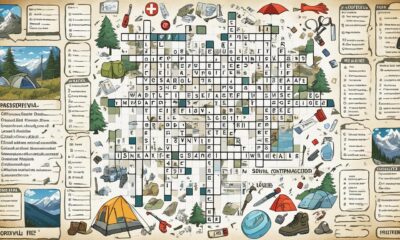
 Survivalism5 months ago
Survivalism5 months agoPreppers Pack Crossword: Test Your Knowledge of Survival Gear!
-

 Survivalism5 months ago
Survivalism5 months agoInside the Secret World of Doomsday Preppers: Are You Ready?
-

 Survivalism5 months ago
Survivalism5 months agoAI Doomsday Scenario: Understanding the Potential Risks
-

 Vetted5 months ago
Vetted5 months ago15 Best Satellite Phones for Preppers: Stay Connected Anywhere, Anytime
-
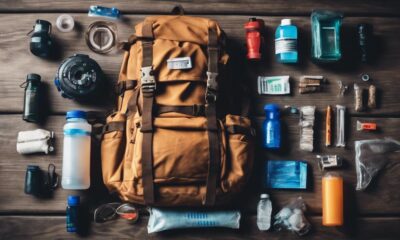
 Survivalism5 months ago
Survivalism5 months agoPreppers List of Items: Essential Gear for Every Survivalist!
-
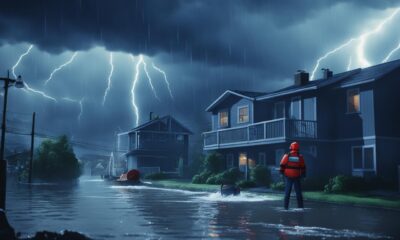
 Survivalism5 months ago
Survivalism5 months agoFlood Survival Tactics: Essential Tips to Stay Safe
-

 Vetted4 months ago
Vetted4 months ago15 Most Durable Survival Gear Essentials for Ultimate Preparedness



